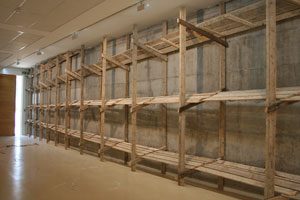Raanan Harlap | The Rear
Curator: Joshua Simon | Artistic Director: Dalia Levin
Sep. 23, 2007 - Dec. 15, 2007
Scaffolding, 2007, sculpture

Raanan Harlap has erected external scaffolding along the concrete wall of the museum’s entrance hall. Scaffolding, set up as a temporary adjunct structure, is an inseparable part of the urban experience. It does not function as an actual structure, but as an auxiliary structure serving a permanent one, hiding it for several months, sometimes even years. It is the workers shaky floor. With the erection of scaffolding in the museum, the exposed concrete wall appear to be in an unfinished temporary state, breaking away from the aesthetic architectural values it is meant to express.